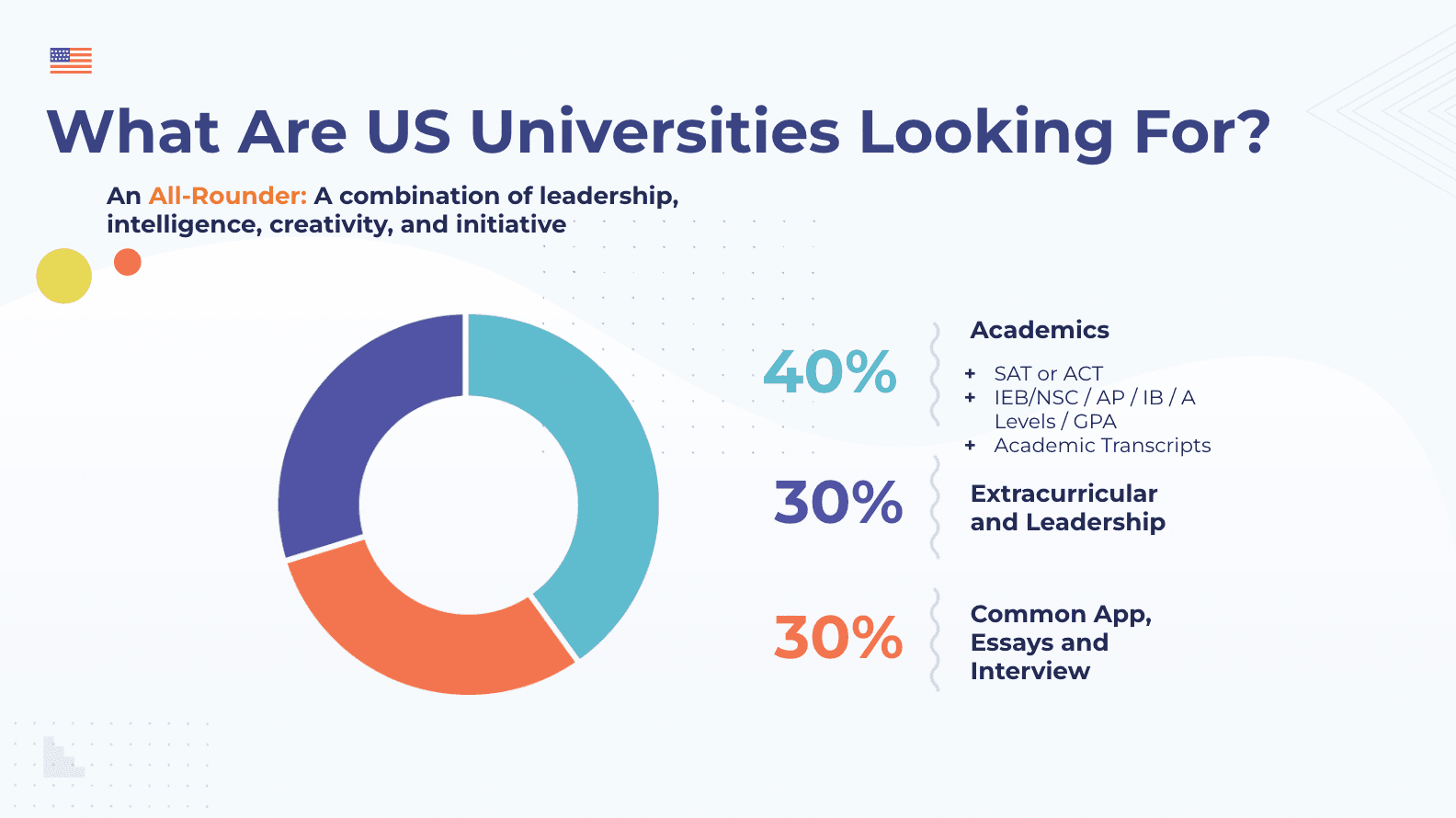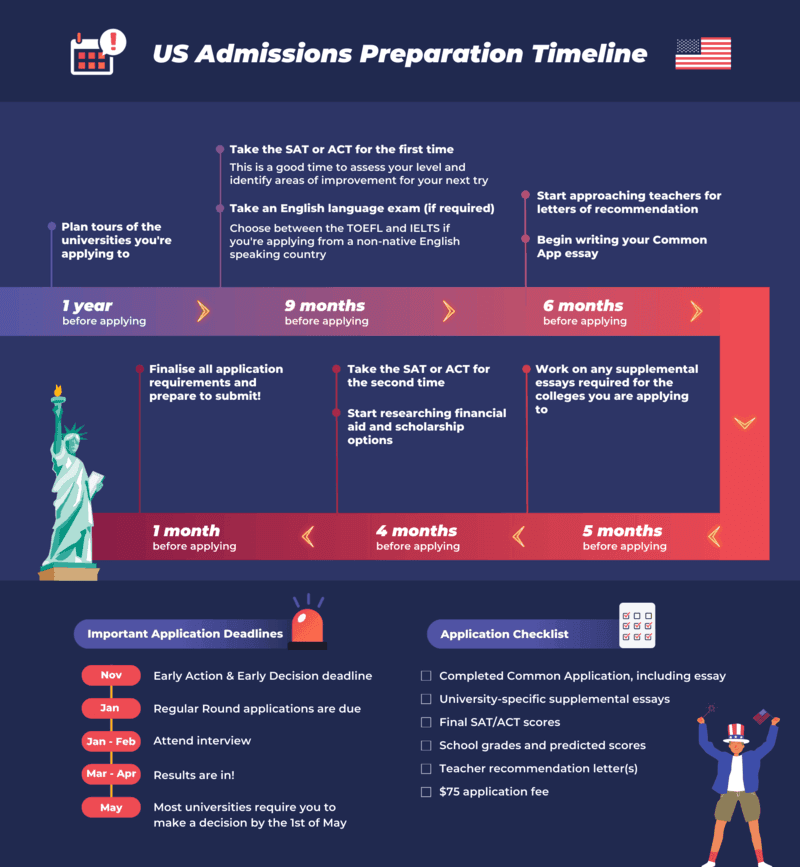How To Apply To US Universities From South Africa

Summary
Applying to college isn’t as easy as it used to be, and it requires so many detailed steps! If you’re staring at your extensive to-do lists and wondering how you’ll manage all the tasks and deadlines, this blog is for you! Believe it or not, you can apply to college without allowing the overwhelming and scary part of the process to take over. We’ll walk you through the application process, providing the best advice and guidance on how to apply to college!
The US is one of the world’s most popular destinations for studying abroad, with more than one million international students studying there each year. Not only are eight of the top 10 global universities located in the US, but it’s also home to more than 5,000 higher education institutions across the country. This blog will break down everything you need to know about applying to US universities as a student from South Africa.
Why Apply to College in the USA?
If you ask US college-bound high school students why they chose to apply to college, you will get countless responses. Applying to any university is a personal choice, and you probably have a unique or maybe even a practical reason you’re choosing higher education in one place or another, especially if you’re applying to the US from South Africa! Here are some of the top reasons you might apply to a university in the US.
- You need a degree for your dream job
- You can’t wait to live out the “college experience”
- You love learning but aren’t quite ready to choose a career path
- You enjoy networking and making connections
- Earning a higher income is important to you
- You love the idea of engaging in activities and clubs with a diverse campus community
- College offers numerous internships and research opportunities
If any of these reasons to apply to college resonate with you, college might be your next step.
What You Need To Know About Applying to US Universities From South Africa
Applying to a university in South Africa is a fairly simple process. For most degree programmes at top public universities like the University of Cape Town, University of the Witwatersrand, Stellenbosch University, or the University of Pretoria, your application will consist mainly of filling out a single form that includes your vital data (name, age, address etc), school marks, and desired degree.
There is very little other information that is required from South African universities, and due to the structure of tertiary education here, your application’s merits are, for the most part, solely based on the marks you achieved. In some cases, you’ll be required to write the NBT.
This is vastly different from the college application process at US colleges. There, your extracurricular activities and personal statement take centre stage, as many top colleges are focused on what you did outside the classroom as well as inside it. With that in mind, we’ve put together a basic guide of things to note about applying to colleges in the US.
Here’s what you need to know if you want to apply to an American college:
- Plan Early. Choose 5+ schools and determine which type of application they accept. Many universities use the Common Application or the Coalition Application, and some require you to apply directly to the school.
- Colleges value extracurricular activities. Choose activities related to your academic interests and aim for leadership positions in those activities.
- Good grades and SAT/ACT scores are still some of the most important parts of your application. Even if the school is test-optional, consider submitting your test scores, especially if you earned high scores. Aim for top grades and top scores.
- The personal essay is supposed to be personal. Universities want you to tell a compelling story and showcase your personality.
- Applying early has advantages. Applying early can increase your chance of acceptance to many top schools. However, you can only apply early to one university, and the decision is binding. Only apply early to a school you're 100% sure you want to attend.
- Carefully read the application requirements. They aren’t always the same for every university.
- It’s ok to be unsure of your major. You can apply to college and mark “undecided” on most applications.
- Don’t forget the application fee. It’s typically $75-$100.
- Acceptance isn’t conditional. If you’re accepted, you’re in!
The US application process can be complicated, and some universities, like MIT and any of the University of California schools, do not use the Common Application. Others have unique requirements beyond the general application. Universities will go into detail about their requirements on their websites. Carefully read the entire application requirements before you get started.
If you’re still unsure you have everything you need, contact one of our academic advisors at Crimson Education. They will walk alongside you and help you navigate the journey. Let’s work together to achieve your academic dreams!
How Eric Got Into Brown University
Key Requirements For US Universities
If you want to study in the USA as a South African student, here are what top American colleges are looking for!

Exceptional Academics
While most colleges and universities will look at your application as a whole, you can’t get away with ignoring your academics. Grades are arguably the most crucial part of your college application, and your chances of getting into college are much higher if you have top marks. You will need to provide a copy of your high school transcript when you apply to college.
If you aren’t sure of how to calculate your GPA, you can check out our guide on how to convert your South African marks to 4.0 GPA scale.
Outstanding Test Scores
The second most important part of your college application is your test scores. While many colleges are going test-optional, some still require an SAT or ACT score, because these scores give schools a better understanding of your academic abilities.
Even if a school is test-optional, you should still write the standardised tests, as colleges will be able to better judge you against other applicants, and your score can only help you stand out.
Most schools look for students with scores in a specific range, so check with your top schools to learn if your scores fit into that range.
Diverse Extracurriculars
Extracurriculars demonstrate who you are outside of the classroom and provide an opportunity to showcase your leadership skills and community involvement. Universities are not looking for applicants who have participated in dozens of extracurriculars. Instead, it’s better to dig deep into a subject, dedicate significant time to it, and ideally use it to propel you into a world-changing career.
Thoughtful Essays
Your essays build upon your applications, giving admissions teams a holistic picture of who you are and how you might contribute to their university. They should include thoughtful and unique information that’s not already in your application.
Strong Letters of Recommendation
Recommendation letters help build your holistic application by allowing people in your life to give their personal and professional opinions about your academic performance, character and drive. If you want to receive favourable and convincing recommendations, establish strong relationships with teachers, key staff, and leaders of your extracurricular activities.
Supplemental Documents
- Transcripts (including grade scale)
- Personal statement
- Reference letters
To learn more, download our free eBook, which provides a complete breakdown on building the perfect application to gain admission into top US universities!
Applying for Scholarships at US Universities
International students are eligible to apply for scholarships offered through their chosen university. Some scholarships have specific requirements, so it’s important to check with the university to find out the details. Read more on Need-Blind vs Need-Aware universities in the US.
The types of scholarships international students can apply for include:
- Crimson Scholarships
- University scholarships
- Financial scholarships
- Merit scholarships
- Country-based scholarships
- Government-funded scholarships
- Privately-funded scholarships
Key Deadlines for US University Applications
Many international students find the US application process complicated. By breaking down the steps into manageable pieces, you will find the process much less daunting and straightforward. Check out the chart below for a complete US admission preparation timeline.

Steps on How to Apply to US Universities
1. Research colleges
Start researching where you might like to study one year before you start applying to universities. Check out each school’s acceptance rates, location, tuition, campus activities, etc.
2. Make a list of your top universities
Make a list of target, reach, and safety schools. Pick schools in all the categories, so you will have more options when acceptance letters come out. Our college admissions calculator can help you find the right universities!
3. Take college tours
Plan a tour (or virtual tour) of the schools on your list. If you can’t get to a college in person, then many resources are available to view and explore the colleges online.
4. Start taking tests.
Take the SAT/ACT for the first time in August of your Grade 11 year, to ensure you have ample time to take it again before your Matric exams.
5. Ask for letters of recommendation.
Start approaching teachers for recommendations about six months before you apply for university.
6. Write your essays
Start writing and refining your college essays, including the Common App essays and/or supplemental essays. Once you’ve decided on a topic, the process of editing and improving can take several months, so make sure to keep revising what you’ve written!
7. Test again
If you’re not happy with your SAT/ACT scores, consider retaking the tests at the beginning of your Matric year.
8. Research financial aid and scholarships
About four months before you apply, research all your financial aid opportunities and any scholarships that will help you pay for university.
9. Put your application together
You should have all the application pieces ready about one month before it’s due. Check and double check you have all the details before submitting your application.
10. Apply for University!
Check your application one last time and press submit!
How do I find an American University that’s Right for me?
You’re the only person who can answer this question. Universities are as unique as the students who go there. If you know what you want to study, choose a university specialising in that study area. If you’re still unsure of what you want to learn, check out:
- Top 10 Degrees in Demand for the Future
- 10 Best Liberal Arts Colleges in the US
- The Best Ivy League Schools
- The Best UC Schools
Think about your academic and personal preferences and goals. Are you interested in a liberal arts education, an Ivy League school, or maybe a school in the University of California system?
Talk with friends, family, and alumni about different schools. Consider visiting your favourite campuses or going on a virtual tour if you can. Crimson has a YouTube channel with videos about students getting into college, a day in the life of a student, and much more! Crimson counsellors can also help you find the universities that best fit your interests and goals.
If you’re wondering if you have the right grades and test scores to get into your top universities, check out our college admissions calculator.
How Crimson Pathfinder can help you with Applying to American Universities
Introduction to Crimson Pathfinder
Applying to American universities takes time, planning, effort, and patience. It’s easy to overlook a step or miss a deadline.
Crimson recently released Pathfinder - a comprehensive in-app tool that not only helps you stay on track but helps you quantify the value of activities you do in preparation to apply to US universities.
Contained within the Crimson app, Pathfinder is a master list of everything you can do during school to increase your chances of admission to top US universities. Pathfinder includes over 280 goals, each with an assigned point value based on how much admissions officers will value that achievement.
Pathfinder ensures you stay on track between now and when you apply to university. It accurately predicts your admission results (based on your achievements) with unbelievable accuracy. Combined with guidance from your personalised strategist, you’ll become a master of your US university applications!
Crimson Education’s academic advisors walk with you through each step of the process. They keep you on track, help you get ready for testing, provide essay reviews, and more! Best of all, Crimson students are 4x more likely to gain admission into their dream university! If you’re interested in applying to a US university or getting started with Pathfinder, contact a Crimson advisor today!
What Makes Crimson Different
Key Resources & Further Reading
- Join our free webinars on US university applications
- Free eBooks and guides to help with the college application process
- How to get into Ivy League Schools
- Make the College Application process simpler with Pathfinder
- What Do Colleges Look For In Students & How To Stand Out
- How to prepare for College in high school










